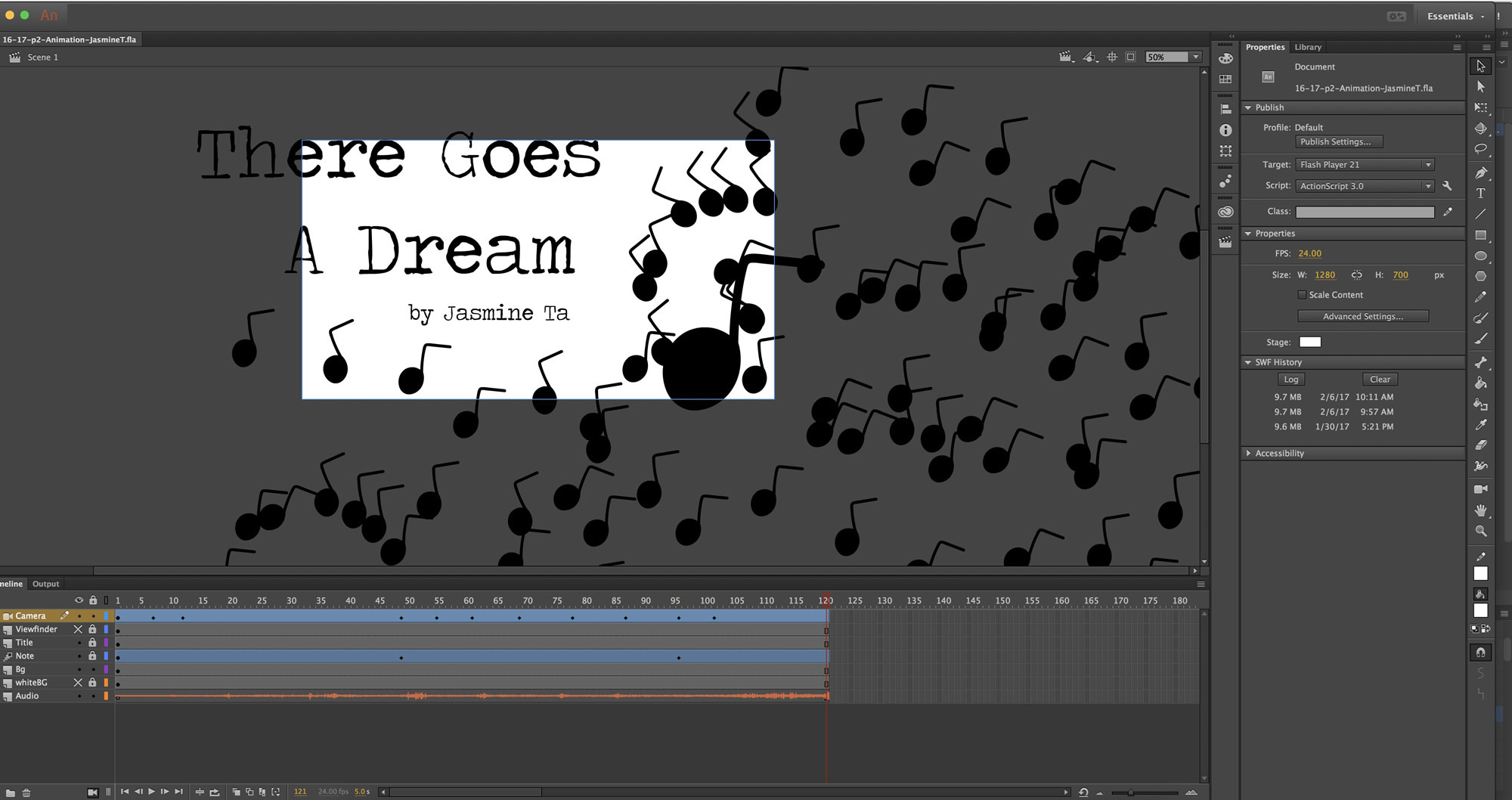The Narrative Unit centered around the expression of a short story through the written word, comics, and animation. For these different projects, it was (unfortunately) extremely necessary to use Illustrator, a program that allowed me to create the images and characters you see above, and Animate, a program that allowed me to create the animation you will see in the Animation tab.
Admittedly, I'm not the greatest artist to enter Freestyle, nor even a decent one at that, so this 'comics' and 'animation' thing was nothing more than a pain in my side. However, I learned a few tricks from my time wrestling around Illustrator and Animate, and I even produced a few GIFs in my free time (granted it took me hours to do each one, but at least it was fun). But most of all, I learned more about this whole 'color scheme' shtick and managed to make my comic look a whole lot nicer in white, black, and grey (you can see the comic on the Illustration tab).




If you look at the image I chose for the header, you can see the words ‘Nar Ide’ in the leftward column. ‘Nar Ide’ is short for ‘Narrative Idea,’ and as you can see, I went through a long process coming up with different storylines about different people who all have pretty much the same problem. Fear is an overwhelming emotion, and it often stops the best of us in our tracks.
The story I chose for this narrative I originally wrote as an even shorter story about someone who has a dream, but refuses to chase after it for some reason. This dream is like an almighty god to them - unattainable, glorious, and formidable. As a change of pace, I wrote this story instead, about a kid who chases after a black butterfly and gets scared by perhaps one of the scariest-looking sleepy hounds ever. The original story goes like this:
I found it flitting around my head one day. It was like a dream, colorful and fantastical. I wanted to reach out my hand to touch it, but I held back. A dream is nothing more than a fantasy… something you keep in your head.
I took pictures of it, wrote stories, drew pictures. From day one to today, I let it fly around my head. Whenever I feel sad or mad, I like to gaze at it, shining like a gem under the blazing sun. Even if things decide to go wrong, this one dream would never fade…
For this project, I delved into my character's story and specifically wrote about their actions, not just their feelings at the time. Through these actions, I showed how the character developed a sense of 'fearlessness' as they threw away their hesitation and ran past their fear of dogs.
Butterfly
In a scenery of purely white noise, it escaped from my chest one day. When I finally noticed it, some minutes later, it had the look of a purely black butterfly. I tried to wave it away, figuring I had probably discarded yet another useless dream. But it stayed and chose to flit around my head, wings working tirelessly to dodge my hand. I admired its tenacity, its unique beauty.
One day, it started speeding away from me, as if possessed by something demonic. I don’t know why, but I felt the need to run after it, to keep its small black wings in my sight. Focused only on this small thing, I ran into something large and overwhelming, the red-eyed glare of a huge, pure black beast. It silently looked at me, judging me with its red beady eyes.
I gulped. I wanted to run, hide, cower. Those eyes scared me, entranced me, chilled me to my very core. I was frozen in place, looking up into those merciless crimson eyes. I didn’t dare twitch, much less shake from fear. My mind ran blank with only the image of a snarling black hound from hell consuming every corner of my vision.
But then my vision was suddenly filled with a fluttering, a rainbow of colors that drew my eyes to it in a wonderful way. My eyes darted to and fro, my attention trying to tell what was flying back and forth so frantically.
A butterfly with wings like an endless rainbow dove up and down for my attention. It dive-bombed to the left and forward, as if trying to leave me behind. I swallowed my fear and forced myself to look away from the beast’s eyes. Letting instinct lead me forward, I sprinted past the beast and after the butterfly. Forgetting that ice cold fear, I ran past that foul beast and took a step toward that scrapped dream.
It led me forever onwards toward a future I had first abandoned; the one dream I was determined to keep.
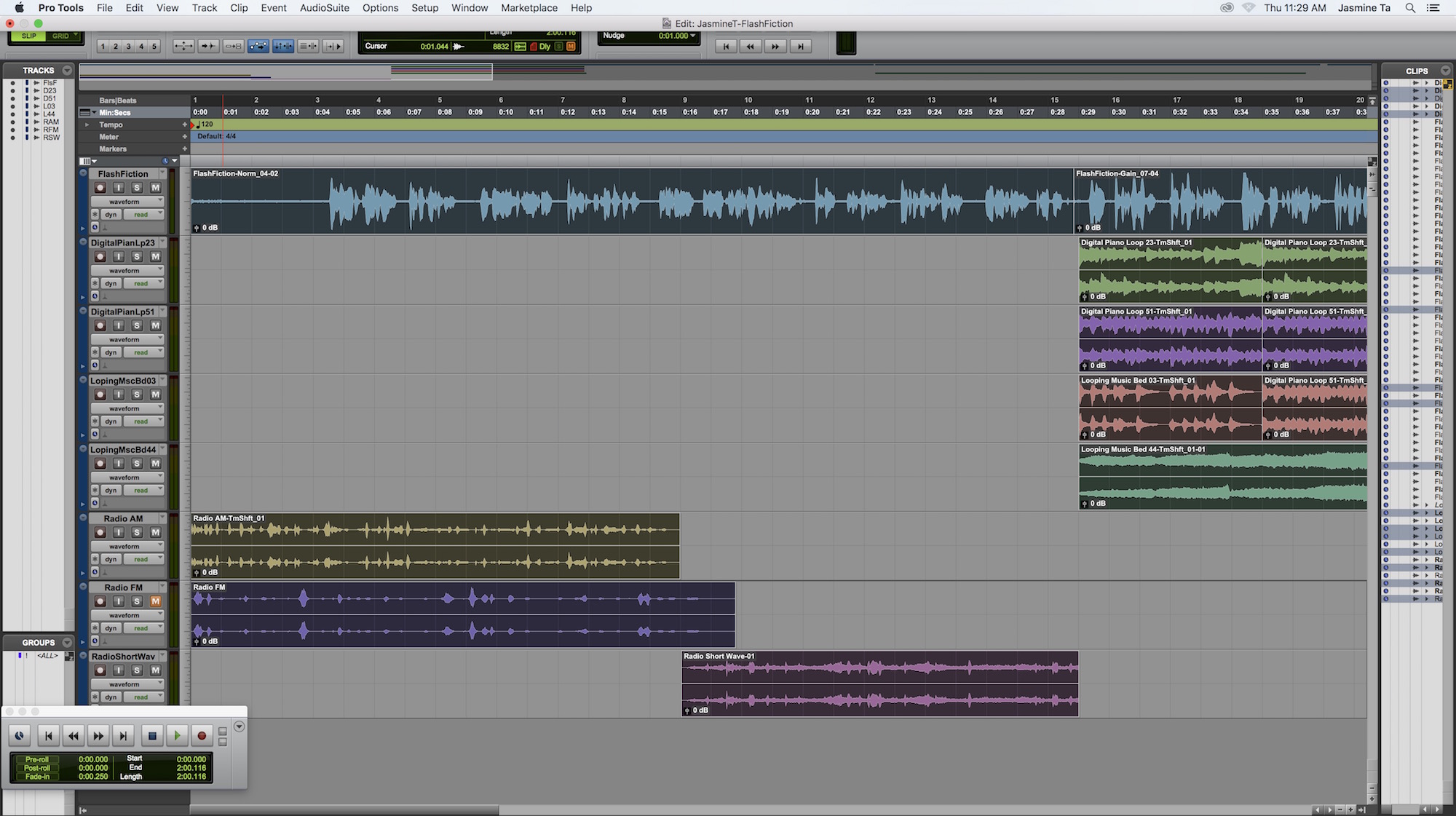
The illustration assignment was to make a comic based off the story students wrote in English. Using new techniques, such as the use of different perspectives, served to make the comic both interesting and informative of the story’s meaning. Students also incorporated their knowledge of the color wheel, blending in symbolic colors to make the comic interesting and telling of their character’s thoughts and feelings.
For design, I learned about 'positive space' or the space the panels should take up. Since these panels were meant to be the center of attention, they couldn't be small specks on the page. Their strange shape would also attract the eye, and in this case, lead them onto the next panel (this comic is read from right to left like a book).
There Goes A Dream

One of the strangest thing about this comic was its origin. It originally existed as some trivial story I wrote about someone who wasn’t sure enough to chase after their dream. Whether it was lack of confidence or ability, I never explained. This comic took that story and turned it around. “There’s this thing I’ve been thinking about and I’m impulsive enough to go after it.”
As terrible a writer I am, I’m an even worse artist. It was difficult and frustrating trying to find some style of art that wouldn’t confuse the reader on the action nor look so bizarrely out of place as to distract. In the end, I did a simplistic style, simplistic enough that I didn’t make a mistake on Illustrator every five minutes and erase an hour’s work.
If there is anything I could change about this strange piece, I might have wanted to work on the main character’s personality, just so they wouldn’t have that perpetual dumb-looking face in every panel. In general, though, the idea of using comics to bring a story together was certainly interesting, and I’d like to incorporate the idea of bringing words and pictures into another interesting thing someday.
In any case, while this project took me several weeks in Illustrator, there were plenty of people who were painstakingly drawing every line in every intricate panel. Their pieces were practically overflowing with symbolism. My piece is about some weird kid who decided to chase after a butterfly. I have newfound respect for people who care about their art, and now I know just how hard it is to create one.
For this project, I was incredibly, egotistically, proud of this story, and then it got cut in two (goodbye, hell hound). This strange redrawing of the rising action of a short story made me realize even in stories shorter than 500 words, there can be a subplot. I wonder if it was worth taking away a subplot involving a hell hound.
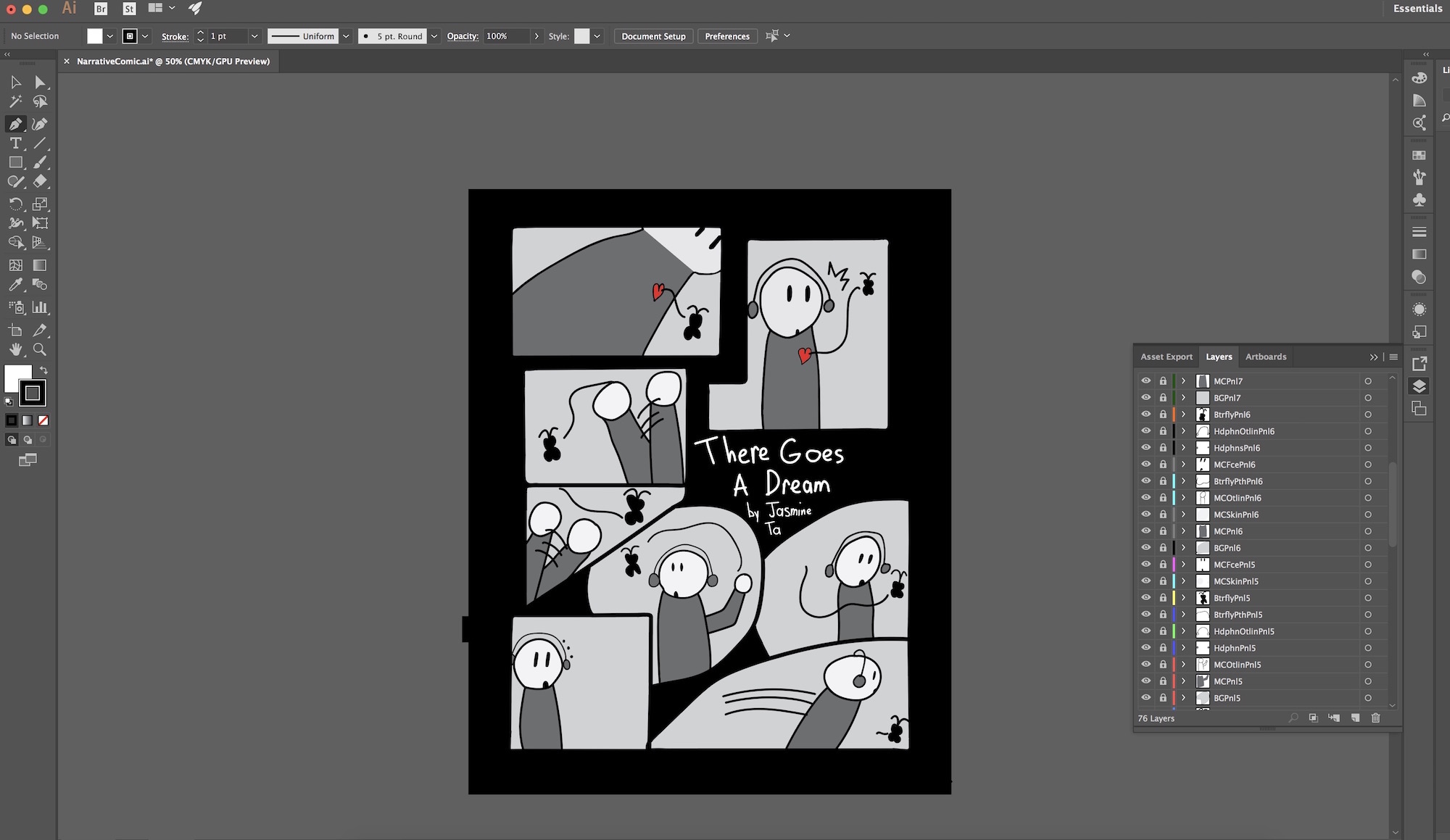
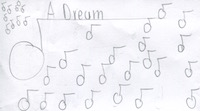
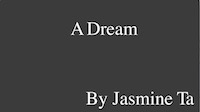
The entire process was time-consuming, infuriating, and possibly the most interesting experience of my junior year. The Flash Fiction was the first step towards an animation, in which I created the story where a main character would overcome something terrible. The next step, the graphic novel, brought the characters to life and made me think about a visual meaning to this character’s struggle. Finally, the animatic planned every scene that would go into the animation, allowing me to decide what kind of music would play, what facial expression should the main character have, and the biggest question: how can I satisfyingly end this story?
To the right of the image below, near the middle, a box labled 'Scene' can be found. In that box are scenes numbered up to 16. Judging by the slider, that was barely half the scenes available. Thus, the constant groaning of 'long, excruciating hours spent on this animation.'
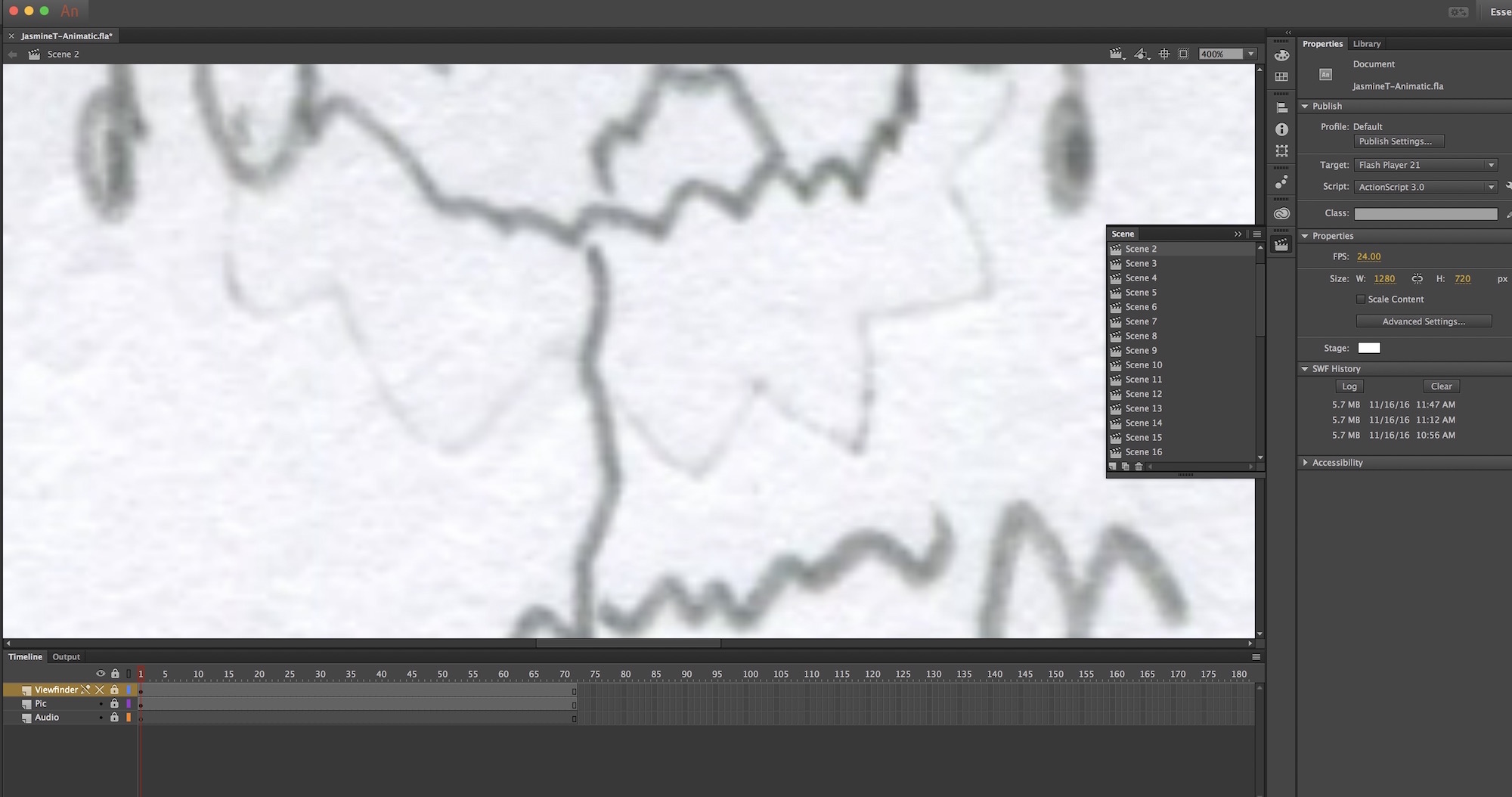
I've never been good at names, one of the reasons why I never officially named my protagonist (in a hurry, when asked, I decided 'Howard' was their name). So, until the illustration, this piece's working title was at first 'Butterfly' and then 'A Dream,' which was supposed to describe the butterfly, though people kept thinking that it was all a dream (half-right, but the butterfly was far more important). In the illustration, though, I finally settled on 'There Goes A Dream,' as the protagonist chased after the butterfly.
From the flash fiction to animation, the process was long, tiring, and frustrating, especially for a terrible artist like me. As a writer, I could handle the flash fiction, so that a reader could easily visualise the action. As an artist though, I did the best I could in drawing the comic, so that it might seem 'dreamlike' with nary a straight line and panels that led the eye to the next panel.
As a Digital Media student, my next assignment was to create an animatic, which, despite using simple drawings, was still time-consuming. This is where I would carefully plan how long the animatic might be, what camera shots I could use, if I might use the perspective of the character as they're running to mimic their breathlessness (which I did).
And then finally the animation. Before I worked on the animation, I mixed togther music and sound effects, testing them on the animatic, before accepting that I'm terrible at music too. The animating process was agonizing and long, with time spent half animating the protagonist by hand and then animating the protagonist through other (more easier) means. At the end of the day, it was a huge relief to be done with this monstrosity, after I plugged in the last bit of music.
As a terrible artist in both music and art, I still somehow managed to keep my ego intact as I worked excruciatingly painful hours on this animation. There were many moments when I made such awfully dumb mistakes, and then there were moments when I decided to give up and cut down my ideals, using easier, less time-consuming scenes. And somehow in the end, I don't think this piece was too bad.
